Emails are the often used and formal method to communicate on the web. People use emails for their formal as well as personal communication. But when it comes to sending sensitive information, there is always the question of trust and confidentiality. Because of that, people prefer to use other P2P and blockchain based services to share such information. But what if the recipient has no idea about these services and only use email, or say, you just have to share a secret message? Well, in such cases, you can send encrypted self-destruct email to the recipients. These emails are encrypted with a password along with an expiration time.
This article covers 4 methods to send encrypted self-destruct email free. With these methods, you can protect the email content with a password and set a self-destruct timer. This lets you easily share sensitive and confidential information without worries. So, let’s check out these methods one by one.
Also read: 4 Free Secure and Encrypted Email Services for Better Privacy
4 Methods To Send Encrypted Self-Destruct Email Free:
Gmail Confidential Mode
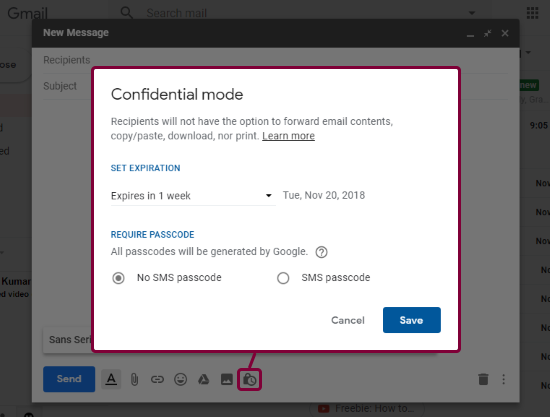
Let’s start by addressing the elephant in the room. Gmail has a built-in option to send emails with an expiration; it’s called “Confidential mode” and sits right next to the image-attachment option in the New Message (Compose) box. This option lets you set an expiration time of 1 day, 1 week, 1 month, 3 months, or 5 years for the email. On top of that, you can also secure the content of the email by enabling the passcode option. This option asks you to type the phone number of the recipient. When the recipient opens the mail, he/she gets a passcode through a text message to access the content. This way, you can write the mail like you usually do and use this mode to make it encrypted and self-destructing.
But, the Confidential Mode is only available for Gmail users. People with another email provider (even G Suite users) can not access the confidential mail. In such a case, you can use SnapMail service instead of this Confidential Mode.
SnapMail.co
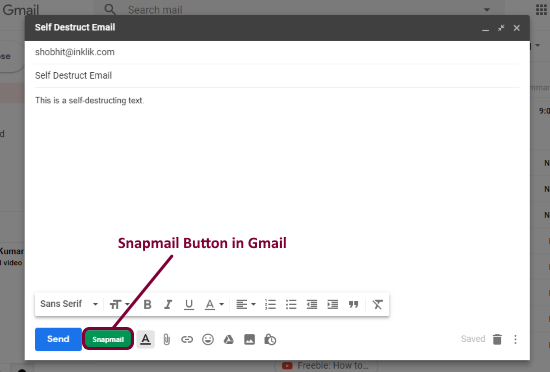
SnapMail is a free extension for Google Chrome that lets you send auto-destructing emails. When installed, this extension adds a Snapmail button next to the Send button in the compose message box of your Gmail. After writing the mail, when you hit this button instead of regular Send, it delivers a link to the recipient’s inbox. The link contains your message and self-destructs it 60 seconds after opening. With this extension, you can easily send self-destructing email to anyone with a valid email address. Do note that, unlike Confidential Mode, SnapMail doesn’t encrypt the message or add a password protection; it just makes it self-destructing.
Try this extension to send self-destruct emails with Gmail here.
Cloakmy.org
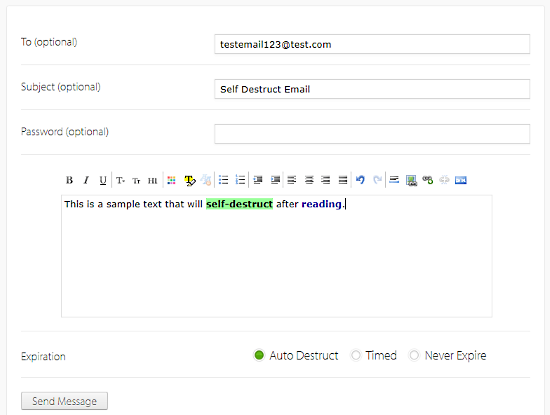
Cloakmy is a free online service to share a secure message. Using this service, you can send encrypted self-destruct email to any email address(es). You don’t have to create an account to use this service. You can simply type your message here and enter the recipient’s email address to send the mail. This service supports rich text format along with photo attachments. You enter the sensitive information and protect it with a password. When you type a password, Cloakmy gives you a secondary password option. The secondary password is used to encrypt the message locally before sending to the server.
Along with the password, you can set an expiration for the message. You can set it to auto-destruct once opened, destruct after a specific time period, or never destruct. In case of the specific time period and never destruct, you get an option to manually delete the message anytime. When you send the message, you get a share-link to share the message manually along with another link to delete the message. The recipient(s) get the share-link in their inbox which takes them to Cloakmy website where they can read your message after typing the correct password(s). When the recipients access the message, they also get an option to delete the message if not deleted automatically.
Send self-destruct emails free with Cloakmy here.
NoteShred.com
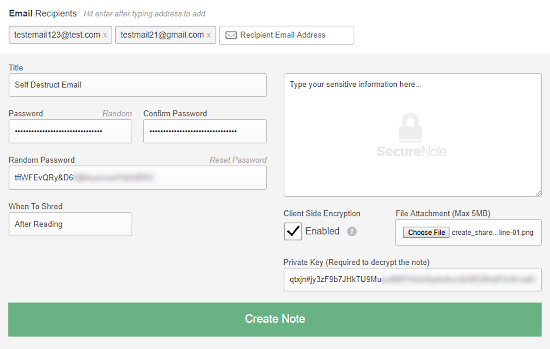
NoteShred is a freemium service to securely share private information online. Here, you can send 10 messages per month for free and remove this limit anytime by subscribing to the premium plan. Using this service, you can send encrypted self-destructing email to multiple recipients at once.
The process of creating a self-destructing and encrypted message is straightforward here. Simply type your message in the text box along with a title and add a password to make it password protected. You can also add a file attachment of up to 5 MB in size. Then, set the validity of the message; you can set it to delete after reading or specify a custom time frame.
This service also gives you an option to add client-side encryption to the message. Enabling this option gives you a primary key which will be required to decrypt the message. Do note that, this option only encrypt the text, the attachment will not be encrypted. Once all set, enter the recipients’ email addresses and send the encrypted email by creating the note.
Send self-shredding emails free with NoteShred here.
SafeShare.io
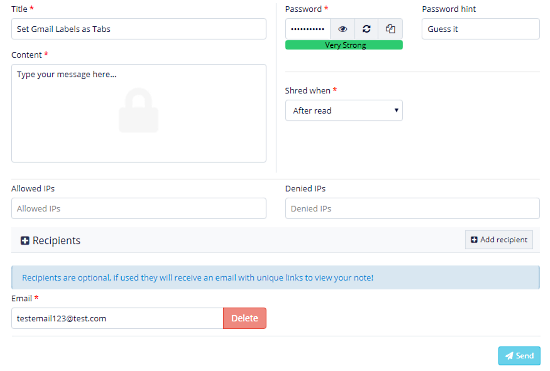
SafeShare is another freemium service to securely share sensitive information online. This service is very similar to NoteShred. Here, you can send 10 notes, 10 snippets, and 10 requests per month for free. It also lets you add allowed and denied IP addresses for your message but it does not support file attachment.
To create an encrypted email, you can simply type/paste your secret message here and add a password for it. You can set the email validity to shred after reading or define the desired expiration time. Then, in the Recipients section, you can add as many recipients you want, type their email addresses and send the self-destructing mail. You can also track the status of your mail here. SafeShare gives you notifications when your mail is opened and shredded.
Send auto-destruct emails free with SafeShare here.
Wrap Up:
These are the 4 simple methods to send encrypted self-destruct mail free. Depending on your needs and requirements, you can use any of these methods to send self-destructing emails. Give them a try and let us know which one you like to use and why.